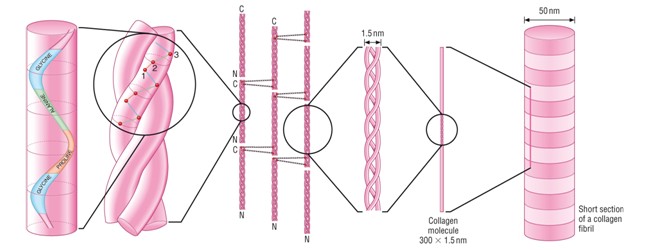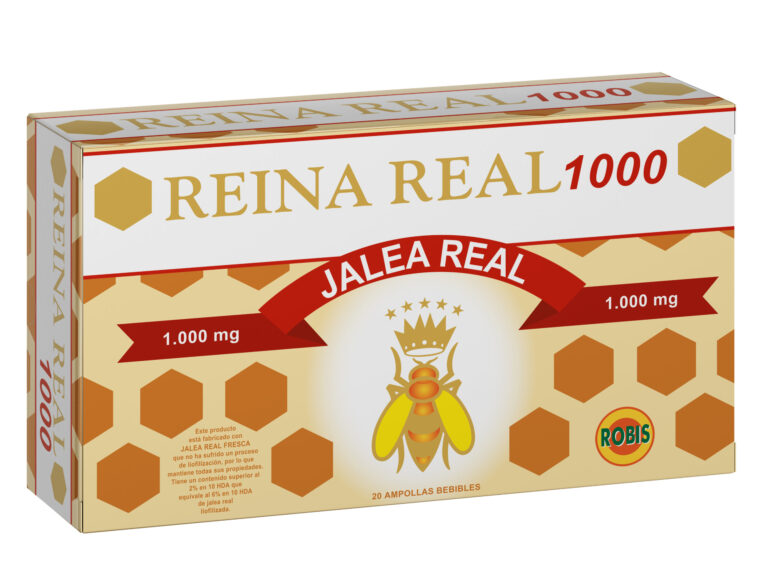The term collagen refers to a natural protein that can be found in all animals and only in animals. It is not found in other living things (plants, algae, fungi, bacteria). It is the most abundant and largest protein in the human body, being the essential constituent of bones, tendons, ligaments, joints, cartilage, as well as the main factor of the firmness of the skin, being able to represent up to 35 % Of total body proteins.
It is produced in the connective tissue by cells called fibroblasts. The molecules are arranged in fibrils and these are associated in turn to form the so-called collagen fibers. These fibers are flexible but have a high tensile strength. They are abundant in all the fibrous tissues, like tendons, ligaments and skin. It is also abundant in the cornea, cartilage, bones, blood vessels, intervertebral discs or dentin.
Being a protein, collagen is composed of amino acids, such as glycine, proline, arginine, hydroxyproline, amino acids that exist in varying proportions depending on the source. As the body’s largest protein, it has a chain of more than 1,500 amino acids.
Digestion breaks down proteins into peptides (groups of amino acids) and individual amino acids, which are absorbed through the intestine and into the bloodstream. Digestion of collagen proteins from the diet is often incomplete, resulting in very long peptide chains. These long molecules are not well used by the body, so to be absorbed, the collagen must undergo a hydrolysis process. After this it will have an absorption of 90%. Therefore collagen will always be hydrolyzed to perform its function.
There are many types of collagen, we will only refer to three of them.
Type I collagen is the most abundant of all of which can reach up to 90% of all collagen in the body. Type I collagen can be found in many tissues and structures. For example, in bones, skin, tendons, cornea, muscles or intervertebral discs. The most prominent function of type I collagen is to provide tensile strength (stretching) while allowing flexibility.
Type II collagen is the major component of cartilage and is also abundant in the vitreous humor of the eye. Collagen type II is used in the treatment of rheumatoid arthritis and osteoarthritis. It is also used in cosmetic medicine to treat cellulite and reduce skin wrinkles. It is used both orally and injected.
Type III collagen has been identified as the second most abundant and appears frequently associated with type I collagen in muscles, skin, intestinal walls, walls of blood vessels.
As collagen production decreases the bones lose density, the joints and ligaments become weaker and less elastic. The skin becomes thinner and wrinkles.
Benefits of Collagen
The health of our bones and joints is fundamental to guarantee a good quality of life.
Bones grow and deteriorate like other organs. Not only age influences its deterioration – as the body ages, collagen levels begin to decrease naturally – there are other factors that can negatively influence such as genetic inheritance, obesity, sedentary lifestyle and certain nutritional deficiencies.
Bones are continually reshaping. It is a process of constant formation and reabsorption in the different stages of life.
A joint is the union between two or more nearby bones. The joints provide elasticity and plasticity to the body. The bones and joints are joined together by cartilage. Cartilage, made up of a network of collagen fibers and proteoglycans, is the firm but flexible tissue that covers the ends of the bones in a joint. When cartilage is worn, the bones rub against each other and damage occurs that can be permanent in bones and joints.
The cartilages help us to cushion the blows when walking and the jumps when running. They help to prevent wear by friction and allow the movements of the joint. The good state of the joints provides a better quality of life.
The sector most affected by this wear, are athletes, people of advanced age due to osteoporosis and osteoporosis problems and overweight people. More than 25% of the population suffers from joint problems due to the wear and tear of the cartilaginous tissue.
As we have already said, collagen is present in the articular cartilage, giving it greater resistance and elasticity, since it acts as a shock absorber, being an important ally to improve the joint function, reducing the friction of the joints and acting as a shock absorber for the bones. For all this the nutritional supplements with collagen provide us with the following benefits:
- They contribute to improve the mobility of the joints and keeps them in perfect health. In treating the causes and not just the symptoms, the mobility of the joints is greatly improved, reducing pain and improving the quality of life
- They prevent sports injuries, such as tendinitis and strains and favor their recovery should they occur. They can help you with meniscal injuries, which can lead to premature cartilage wear
- They maintain the flexibility and lubrication of the joints, favoring the optimum preservation of the cartilage, slowing the wear and tear of the joints
- They contribute to reducing pain in the elderly and those who exercise
- They provide elasticity and firmness to the skin, preventing wrinkles and sagging. When we pass the age of 30, the production of collagen in our body begins to diminish, wrinkles appear and the skin becomes more flabby
- They improve the appearance of nails and hair




